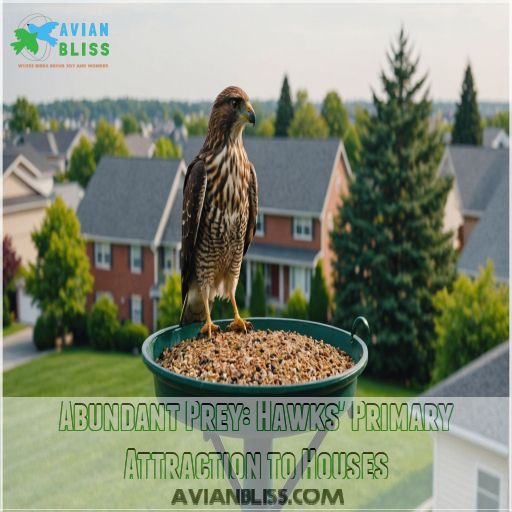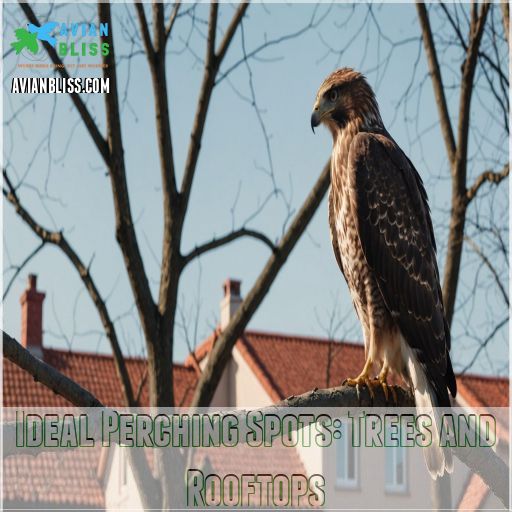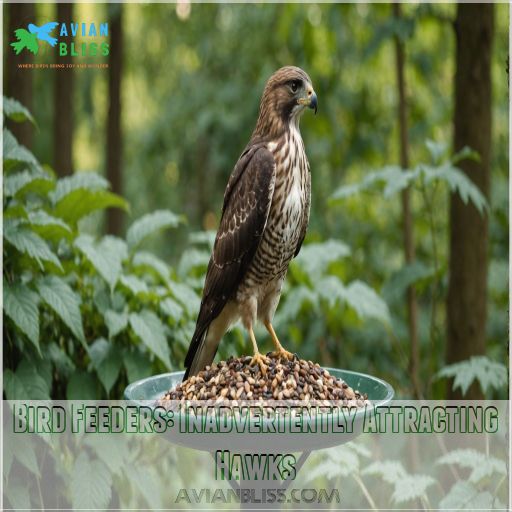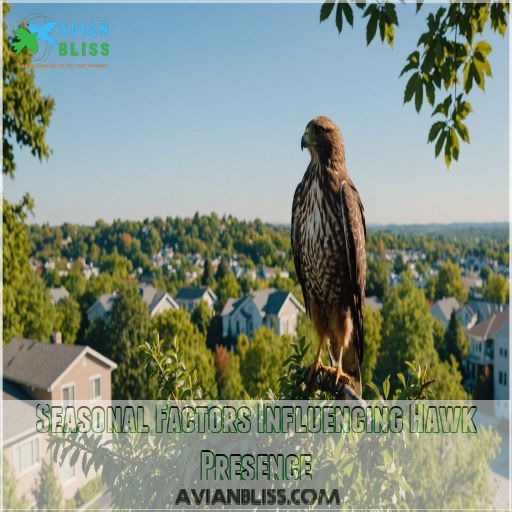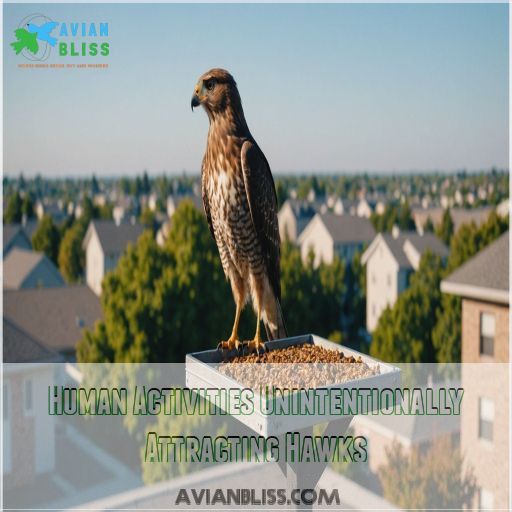This site is supported by our readers. We may earn a commission, at no cost to you, if you purchase through links.
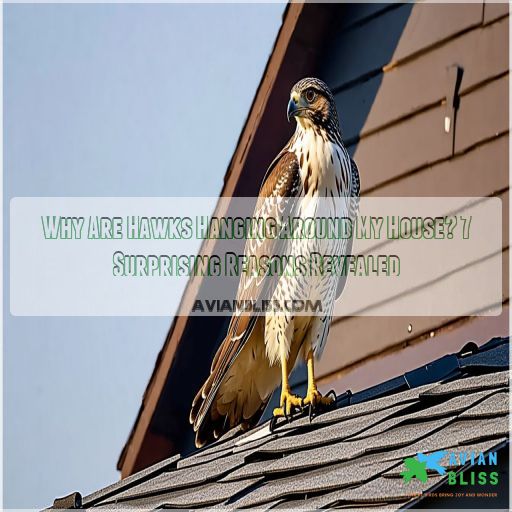 Ever wondered why hawks are hanging around your house? It’s not because they’re plotting a takeover! These majestic birds are likely drawn to the buffet of prey in your yard.
Ever wondered why hawks are hanging around your house? It’s not because they’re plotting a takeover! These majestic birds are likely drawn to the buffet of prey in your yard.
From mice scurrying through your garden to songbirds at your feeder, your property’s a hawk’s dream diner. They’re also fans of tall perches like trees and rooftops, perfect for spotting their next meal.
Don’t be surprised if you see them more often – hawks are adapting to urban life like champs. While they might ruffle some feathers, these feathered friends are nature’s pest control experts.
Curious about how to coexist peacefully with your new neighbors?
Table Of Contents
- Key Takeaways
- Abundant Prey: Hawks’ Primary Attraction to Houses
- Ideal Perching Spots: Trees and Rooftops
- Hawks Adapting to Urban and Suburban Environments
- Your Property: a Perfect Hunting Ground
- Bird Feeders: Inadvertently Attracting Hawks
- Nesting Sites: Hawks Seeking Safe Homes
- Seasonal Factors Influencing Hawk Presence
- Human Activities Unintentionally Attracting Hawks
- Natural Pest Control: Hawks’ Role in Ecosystems
- Legal Protections and Coexisting With Hawks
- Frequently Asked Questions (FAQs)
- Why do Hawks stick around?
- Do hawks live in urban areas?
- Why do Hawks hang around my house?
- Are hawks around your house a problem?
- What does it mean when a hawk hangs around your house?
- Why would a hawk be hanging out in my yard?
- What does it mean when a hawk visits your home?
- What does it mean when a hawk keeps coming around?
- Are hawks dangerous to humans?
- How long do hawks typically stay in one area?
- Can hawks recognize individual people or pets?
- Do hawks hunt at night?
- What sounds do hawks make around houses?
- Conclusion
Key Takeaways
- You’ve got a hawk buffet in your backyard! These birds are drawn to areas with plenty of prey, so if you’re seeing hawks, it’s likely because your yard is teeming with small animals they love to snack on.
- Your property might be a five-star hawk hotel. These birds appreciate tall trees for perching and nesting, open spaces for hunting, and water sources that attract their prey. It’s like you’ve accidentally created a hawk paradise!
- Hawks are nature’s pest control experts. While they might ruffle your feathers by hanging around, they’re actually helping keep rodent and pest bird populations in check. It’s like having a free, eco-friendly exterminator on call.
- You can’t evict your feathered neighbors, but you can learn to coexist. Hawks are protected by law, so focus on humane deterrent methods if needed. Remember, their presence is a sign of a healthy ecosystem, so try to appreciate these majestic birds from a safe distance.
Abundant Prey: Hawks’ Primary Attraction to Houses
You’ve noticed hawks hanging around your house, and the reason might be simpler than you think.
These skilled predators are likely drawn to the abundance of prey in your area, such as small mammals and birds that call your neighborhood home.
Common Prey Animals in Residential Areas
Your backyard’s a buffet for hawks! Mice, voles, and squirrels top the menu, with rabbits and birds as tasty side dishes. These common prey animals thrive in residential areas, making your neighborhood a hawk’s dream diner.
Even your small pets might look like appetizers to these sharp-eyed predators. It’s nature’s way of keeping things in check, but it can be a bit unnerving when you’re sipping coffee on the patio!
How Prey Populations Influence Hawk Presence
Hawks are nature’s sharp-eyed troubleshooters, keeping prey populations in check (Source). When rodents run rampant or small birds flock to your feeders, these winged warriors swoop in for some natural pest control. It’s like they’ve got a built-in GPS for abundance!
They’re highly adaptable, as seen in Coopers Hawks’ ability to hunt in urban environments. Additionally, this adaptability allows them to play a key role in controlling small mammal and songbird populations.
- Prey availability drives hawk presence
- Urban environments create new hunting grounds
- Seasonal changes affect prey and hawk behavior, especially during a Red-Shouldered Hawk’s hunt for small mammals in suburban areas
Remember, a thriving ecosystem is all about balance. Hawks aren’t just hanging around – they’re helping maintain your backyard’s delicate ecological dance.
Signs of High Prey Density Around Homes
A bustling backyard often signals a smorgasbord for hawks.
Keep an eye out for these telltale signs of high prey density: increased rodent activity, abundant bird droppings, and tiny tracks in the soil.
You might spot more squirrels scurrying about or notice a surge in activity around your bird feeders.
Dead prey remnants or a sudden decrease in small wildlife could also indicate that hawks have found their hunting grounds.
These signs suggest your property’s become a hawk’s paradise.
Ideal Perching Spots: Trees and Rooftops
Nature’s high-rise apartments have become prime real estate for our feathered neighbors.
Trees and rooftops offer hawks the perfect vantage points to survey their surroundings and spot potential prey.
Tall trees, especially those with sturdy branches near the crown, provide ideal perching spots for red-tailed and Cooper’s hawks, with distinctive capped heads like Coopers Hawk Features. These avian predators prefer perches that give them a bird’s-eye view of the landscape, allowing them to swoop down on unsuspecting meals.
Your home’s roof might also serve as a convenient lookout, particularly if it has a steep pitch or decorative elements that offer secure footing.
Red-shouldered hawks often favor lower perches, so don’t be surprised to spot them on fences or lamp posts.
Remember, these raptors are simply following their instincts, searching for the best spot to keep an eye on their hunting grounds .
Hawks Adapting to Urban and Suburban Environments
You might be surprised to find hawks in your neighborhood, but these adaptable birds are making themselves at home in urban areas.
As cities grow, hawks are learning to thrive in these new environments, taking advantage of the abundant prey and nesting spots that residential areas provide, in particular, the urban areas.
Urbanization’s Impact on Hawk Habitats
As cities expand, hawks are adapting to urban environments with surprising resilience.
You might spot these birds of prey perched on lamp posts or air conditioners, hunting in parks, or nesting on tall buildings.
This habitat change has led to some hawks living as close as five blocks apart, compared to their usual two-square-mile territories in the wild.
Urban areas offer new hunting grounds, with rats, mice, and pigeons becoming common prey for these adaptable raptors, illustrating their ability to thrive in urban environments.
Benefits of Residential Areas for Hawks
Imagine your backyard becoming a hawk’s haven.
These majestic birds appreciate residential areas for the buffet of food sources like rodents, abundant perching spots, and cozy nesting areas.
Laws protect their safety, while smart homeowners use visual deterrents to prevent property damage.
With the right balance, you can share your space with hawks without ruffling feathers.
Increased Sightings of Hawks in Cities
One reason you’re seeing more hawks around your house is their ability to adapt to urban and suburban environments.
These adaptable raptors thrive on the abundant prey, ideal perching spots, and nesting sites found in residential areas.
As cities expand, hawks are increasingly making themselves at home, so keep an eye out for these impressive birds of prey.
Your Property: a Perfect Hunting Ground
Your backyard might be a hawk’s dream buffet if it has open spaces and a water source, creating an ideal hunting ground.
Landscaping features like tall trees and shrubs provide perching spots that attract these skilled hunters to stake out their prey.
Open Spaces for Hawk Hunting
Your property might be a hawk hunting hotspot due to its appealing openness.
Hawks love:
- Open fields vs. woodlands for easy prey spotting.
- Habitat preferences that echo their natural environments.
- Impact of urbanization, pushing them to suburban areas.
For some peace of mind, consider bird netting or contacting local animal control authorities for guidance.
Water Sources Attracting Potential Prey
After exploring open spaces, consider water sources. They’re like a five-star restaurant for hawks seeking prey.
A simple pond can boost frog populations, increasing prey availability and impacting the hawk diet, which is explained in detail in Wisconsin’s diverse range of birds of prey.
To deter visitors, try aluminum foil and reflective tapes.
Hearing hawk sounds nearby? That’s your property becoming a wildlife hub! .
Landscaping Features That Appeal to Hawks
Imagine a hawk-eye view of your yard—tall trees, open fields, and native plants make it a feast for raptors.
Add bird baths and water features, and you’re basically rolling out the red carpet.
These landscaping features create an ideal hunting ground, and while wind chimes might add ambiance, they’re no deterrent.
Remember, hawks are federally protected, so enjoy their visits!
Bird Feeders: Inadvertently Attracting Hawks
Bird feeders bring lively songbirds to your yard, but they also create a banquet that hawks find hard to resist.
While you’re enjoying the chirping visitors, you might notice these stealthy predators swooping in for a surprise snack.
How Feeders Create Prey Hotspots
Bird feeders can transform your yard into a hawk’s buffet. By attracting small birds, feeders become prey hotspots, drawing these raptors close.
Placing feeders near cover like shrubs helps protect your feathered guests.
Alternatively, consider hanging shiny compact discs nearby; they might just deter hawks with their reflective glint, offering a clever, humane solution.
Types of Birds That Attract Hawks
Your bird feeders may be inadvertently attracting hawks. Cooper’s Hawks and Sharp-shinned Hawks often target common feeder birds like Mourning Doves, American Goldfinches, and House Finches found in Michigan’s woodlands. These flocking species make easy prey for the hawks’ lightning-fast strikes.
Keep an eye out for these signs:
- Sudden silence at your feeders
- Blue Jays loudly scolding
- A flurry of birds fleeing
- Piles of feathers on the ground
Balancing Bird Feeding With Hawk Deterrence
Consider tweaking your bird feeder design to deter hawks like the sharp-shinned hawk vs american kestrel types of bird species while still welcoming small birds. Use hawk-safe feeders with protective covers and place them near shrubs for quick escapes, as hawks have exceptional eyesight that allows them to detect potential competitors, identify prey, launch aerial attacks, and defend nesting sites see Hawks’ Exceptional Eyesight.
Additionally, hawks play a significant role in controlling rodent populations, so reducing prey by keeping ground areas clean and tidy can also help.
Try these coexistence strategies to enjoy watching your feathered friends without creating a hawk’s buffet.
Nesting Sites: Hawks Seeking Safe Homes
You might find hawks picking your backyard as a nesting site because it offers high trees and cozy corners that they prefer for raising their young.
Hawks are tidy homebuilders, often using sticks, leaves, or even your discarded twigs to create a safe refuge for their chicks.
Preferred Nesting Locations for Different Hawk Species
Instead of just swooping by your bird feeders, hawks might choose your yard for nesting.
Hawks prefer nests in:
- Tall trees for greater protection and Nest Height.
- Quiet spots ensuring Nest Defense from predators.
- Strategic Nest Placement near water or open fields.
Having hawks as neighbors? It’s like hosting nature’s drama series in your backyard!
Nesting Materials Found in Residential Areas
After choosing the perfect nesting site, hawks seek materials to build their cozy homes.
You might notice them gathering sticks, twigs, and even recycled materials like bits of wire or paper from your yard.
Surprisingly, human impact often provides abundant nesting supplies, whether it’s fallen branches or man-made debris.
Hawks adapt well, weaving these into strong, secure nests .
Signs of Hawk Nesting Activity
Spotting hawk nesting activity around your home can be fascinating. Look for twig-filled nests high in trees, where parents vigilantly watch over eggs and nestlings.
But be aware that some nests mightn’t be built by hawks alone – Great horned owl nesting often involves taking over existing nests from other birds, even hawks.
You might notice hawks bringing nesting materials or hunting nearby. Their parental behavior is protective, ensuring offspring are safe from threats while keeping you entertained with their aerobatic prowess.
Enjoy the show responsibly!
Seasonal Factors Influencing Hawk Presence
You’ll find that hawks around your home often follow predictable seasonal patterns based on migration, breeding, and winter survival tactics.
They might settle in during spring for nesting or pop by in winter, searching for a warm place and an easy meal, much like you might look for a cozy spot with hot cocoa.
Migration Patterns of Different Hawk Species
As the seasons change, you may notice hawks circling overhead. These majestic birds follow distinct migration patterns, with some species traveling thousands of miles to their wintering grounds. Their presence is often tied to the availability of prey, ideal perching spots, and the timing of breeding and nesting cycles.
- Hawks may migrate to your area in late summer, then depart for winter ranges in the fall, and return to breeding grounds in spring.
- Some hawks maintain year-round territories, while others make shorter regional migrations.
- Migration timing and routes can vary by species, age, and gender.
- Challenges like weather, habitat loss, and hunting can impact hawk migration patterns.
Breeding Season Behavior and Territory Establishment
During breeding season, hawks become your feathered neighbors.
With a lifespan of up to 15-40 years in the wild, and some species like the banded ospreys reaching up to 32 years Hawks in the Wild Lifespan, these avian architects establish territories to select mates, build nests, and rear chicks.
You’ll notice them displaying aerial acrobatics and vocalizing to fend off rivals.
Their presence peaks with abundant prey, ensuring their young have a buffet.
So, if hawks choose your home, consider it a compliment to your property’s ecosystem.
Winter Survival Strategies in Residential Areas
Winter brings new challenges for hawks, but your neighborhood might be their cozy retreat. These clever birds have mastered the art of urban survival, turning your backyard into their winter wonderland.
Let’s peek into their cold-weather playbook:
- Feathered feast finders: Hawks zero in on bird feeders, nature’s drive-thru for easy meals
- Snug as a hawk in a rug: They seek shelter in dense trees or even on buildings
- Warmth warriors: Hawks conserve energy by lowering their body temperature at night
Human Activities Unintentionally Attracting Hawks
Your everyday activities might be rolling out the welcome mat for hawks without you realizing it.
From leaving pet food outdoors to improper garbage disposal, these innocent habits can create a buffet for rodents and other prey.
Turning your yard into a hawk’s favorite hunting spot.
Outdoor Pet Feeding and Its Consequences
Your outdoor pet feeding habits might be rolling out the red carpet for hawks as dead animal scavengers.
When you leave pet food outside, you’re not just feeding Fluffy or Fido – you’re setting up an all-you-can-eat buffet for smaller critters.
This prey bonanza attracts hawks, creating a potential wildlife conflict.
To keep your pets safe and avoid unwittingly luring predators, consider feeding your furry friends indoors or supervising outdoor mealtimes.
Garbage Disposal Practices Attracting Rodents
Garbage day might be attracting more than just the neighborhood raccoons. Improper waste disposal can turn your yard into a rodent buffet.
To keep these unexpected guests at bay, use rodent-proof containers and practice proper garbage storage.
Reduce food waste, secure outdoor trash cans, and you’ll be less likely to host a hawk’s all-you-can-eat feast.
Remember, a tidy yard is a hawk-free zone!
Compost Piles as Prey Magnets
Composting is eco-friendly, but it can turn your backyard into a hawk’s buffet.
Those nutrient-rich piles attract insects and rodents, which are like a dinner bell for hungry hawks.
To keep hawks from circling, bury fresh food waste 6 inches deep and cover it with finished compost (Source).
Avoid adding meat, cheese, or oily leftovers to your pile—they’re like catnip for rodents and their winged predators.
Natural Pest Control: Hawks’ Role in Ecosystems
You might be surprised to learn that hawks hanging around your house are actually doing you a favor.
These skilled hunters play a key role in controlling pest populations, helping to maintain a healthy balance in your local ecosystem.
Benefits of Hawks for Rodent Population Control
Hawks are nature’s own pest control squad, keeping rodent populations in check around your home.
These feathered friends can devour up to 12 mice in a single night, making them more effective than any trap you could set (Source).
By attracting hawks, you’re enlisting a natural, eco-friendly solution to rodent problems. It’s like having a silent, flying exterminator on your side, maintaining the eco-balance without harmful chemicals or poisons.
Impact on Other Pest Species
Rodents aren’t the only pests that’ll make a hawk’s mouth water.
Cooper’s hawks, with their blue-grey upperparts and reddish underparts providing camouflage, love to snack on pesky birds like house sparrows and European starlings, showcasing their adaptability to urban environments like backyards and urban parks Cooper’s Hawk Habitat.
It’s like having your own aerial pest control squad, keeping your garden in check without lifting a finger. Talk about a win-win situation for your backyard ecosystem!
Ecological Balance in Residential Areas
Your backyard’s ecosystem is like a delicate dance, and hawks play a starring role.
These majestic birds help maintain bird diversity by keeping invasive species in check. They’re nature’s pest control, tackling rodents that might otherwise wreak havoc on your urban garden.
By embracing hawks, you’re supporting backyard wildlife and reducing human impact on local ecosystems. It’s a win-win for you and Mother Nature!
Legal Protections and Coexisting With Hawks
Hawks are protected by law, so you’ll need to find ways to coexist with these majestic birds.
You can use humane deterrent methods to keep hawks at a safe distance while appreciating their important role in our ecosystem.
Laws Protecting Hawks and Other Raptors
While hawks play a key role in pest control, it’s important to know they’re protected by law.
The Migratory Bird Treaty Act (MBTA) makes it illegal to harm, trap, or harass these majestic birds.
You might be thinking, "But what if they’re causing trouble?" Well, here’s the scoop: even if a hawk’s hanging around your backyard diner, you can’t shoo it away.
Instead, let’s explore how to peacefully coexist with these feathered neighbors and find a solution that works for both you and the hawks.
Humane Deterrent Methods for Residential Areas
Now that you know hawks are protected, let’s talk about keeping them at bay without ruffling any feathers. Think of it as a game of "hide and seek" with your feathered friends.
Here are some hawk-proofing tricks to try:
- Hang reflective objects like pie tins to confuse flying predators
- Install a fake owl statue and move it regularly
- Plant shrubs and bushes for chickens to hide under
- Use netting or fishing line over open areas
- Consider sound deterrents or motion-activated sprinklers
These methods can help you coexist peacefully with hawks while keeping your garden and pets safe.
Appreciating Hawks’ Presence Safely and Responsibly
Nature’s winged guardians are protected by law, so it’s essential to appreciate hawks from a safe distance.
The Migratory Bird Treaty Act shields these majestic birds, making it illegal to harm or capture them.
Coexisting with hawks means adapting your behavior: secure small pets, avoid leaving food outdoors, and use hawk-safe deterrents if necessary.
Remember, these skilled hunters play a key role in maintaining ecological balance in your neighborhood.
Frequently Asked Questions (FAQs)
Why do Hawks stick around?
Hawks stick around because you’ve got a buffet in your backyard!
They’re drawn to abundant food sources like small birds, rodents, and even pet food.
Your property might also offer cozy nesting spots or shelter during harsh weather.
Do hawks live in urban areas?
You’ll spot hawks in urban areas more often these days.
They’ve adapted to city life, nesting on buildings and hunting in parks.
Red-tailed hawks even thrive in places with fewer trees, as long as there’s enough prey around.
Why do Hawks hang around my house?
Your home’s a buffet for hawks! They’re drawn to abundant prey like rodents and small birds.
Nearby nesting spots or unusual weather patterns might also explain their presence.
Don’t worry, these feathered neighbors are just following nature’s GPS to your backyard diner, a buffet for hawks.
Are hawks around your house a problem?
Spotting hawks near your home can be concerning.
While they may pose a threat to small pets and chickens, hawks also play a key role in ecosystem balance.
Take precautions like providing cover for vulnerable animals.
What does it mean when a hawk hangs around your house?
A hawk’s presence near your home isn’t just happenstance.
It’s nature’s way of delivering a message.
These majestic birds symbolize clarity, wisdom, and the need to see life’s bigger picture.
They’re nudging you toward personal growth and expanded consciousness.
Why would a hawk be hanging out in my yard?
Hawks hang around your yard for food and habitat.
They’re drawn to areas with bird feeders, which attract prey.
These skilled hunters may be juveniles calling for parents or adults seeking easy meals.
Don’t worry, it’s nature’s way!
What does it mean when a hawk visits your home?
Like a messenger from the skies, a hawk’s visit carries spiritual significance.
It’s telling you to trust your instincts and intuition.
This winged visitor might be signaling success or the need for action in your life.
What does it mean when a hawk keeps coming around?
A frequent hawk visitor might be bringing you a message.
These birds symbolize wisdom, clear-sightedness, and guardianship.
They’re likely drawn to your yard’s abundance of prey, like small birds or rodents.
Keep an eye out for nature’s lessons!
Are hawks dangerous to humans?
You needn’t worry much about hawks.
They’re generally wary of humans and won’t attack unless provoked.
While they might swoop close if you’re near their prey, they’re not out to get you.
Just stay alert and respectful.
How long do hawks typically stay in one area?
Prepare for a wild ride! These feathered neighbors might stick around for an eternity or vanish in a flash.
Some hawks set up shop year-round, while others are just passing through, staying 4-5 days before moving on.
Can hawks recognize individual people or pets?
Hawks possess remarkable facial recognition abilities.
They can remember individual people and pets, often recalling past interactions.
This skill helps them navigate their environment, avoid potential threats, and even forge surprising connections with humans who’ve shown kindness.
Do hawks hunt at night?
As night falls, most hawks hit the hay.
They’re typically daytime hunters, but some species break the mold.
Letter-winged kites are night owls among hawks, while others might occasionally hunt after dark under bright moonlight or artificial lighting.
What sounds do hawks make around houses?
You’ll hear a variety of sounds from hawks near your house.
Adult red-tails emit a piercing "KEEEEEEEEE-ARR" scream, while juveniles make adorable two-note whistles: "wee-EEE, wee-EEE!"
These calls serve different purposes, from hunting to communication.
Conclusion
Imagine a hawk soaring gracefully over your neighborhood, keeping a watchful eye on the urban landscape below.
Understanding why hawks are hanging around your house reveals a fascinating world of nature in our midst.
By appreciating their role in pest control and adapting our habits, we can coexist harmoniously with these magnificent birds.
Remember, their presence is a sign of a thriving ecosystem. So next time you spot a hawk nearby, take a moment to marvel at nature’s perfect balance right in your own backyard.

